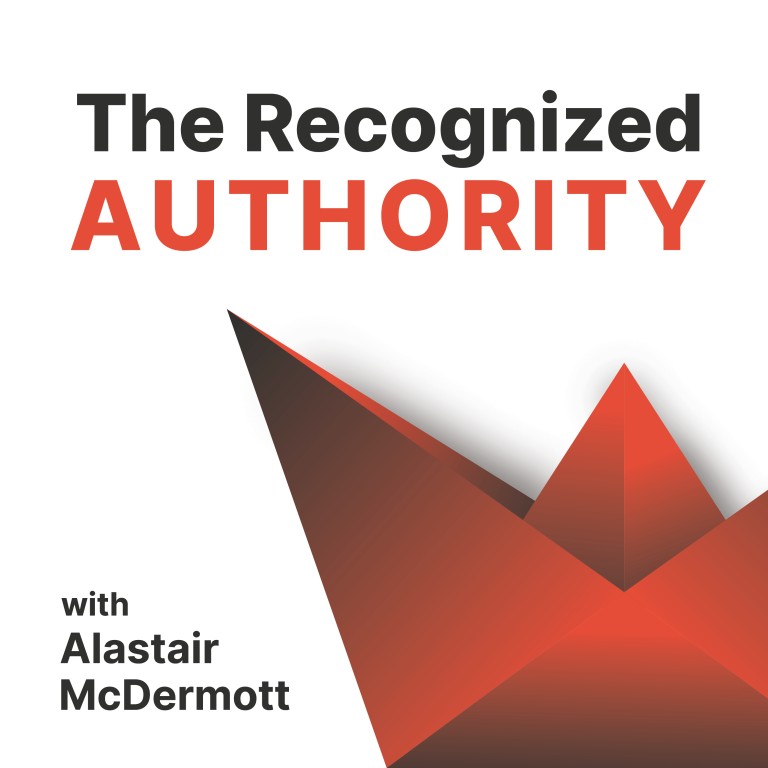SUMMARY KEYWORDS
podcast, goal, consultants, subscribers, number, podcast episodes, week, reporting, episode, email list, products, sales pages, hosts, track, marketing, lead magnets, book, webinar, call, talk
SPEAKERS
Alastair McDermott
Alastair McDermott 00:00
Hi there, folks, you’re very welcome to a bonus episode of the Marketing for Consultants podcast. So this one’s a little bit different. Normally I do interviews and today I’m doing a solo recording. What I’m doing is I’m sharing something with you that I shared with my email list last week on Friday. So it is what I call a transparency update. And the logic behind this is I think that it’s good idea to if you’re open to it, to share some numbers from your business. And it can be good for accountability. It can be good to be authentic, and it can help them with trust. Like there’s a lot of positives doing it.
I got this concept from a guy called Rand Fishkin, he founded Moz, one of their mantras, or mottos was, I think they call it tag fi, the T stands for transparency, a for authenticity, and I can’t remember the rest of them. But yeah, so that’s where I got this from.
So I’m doing this, I’m recording this both as a video, which will be on YouTube. And there’s a podcast episode, which will be on the podcast, obviously. And what I’m going to do is, I’m going to put a link in to the YouTube video in the show notes for the podcast. And I’m also doing a screen share in the video. So listen to the podcast, I’ve got these the numbers I’m talking about. And that is actually showing up on the screen as I talk to them.
Okay. The first thing I’m going to mention is that the total revenue to date for Marketing for Consultants is zero. And I can imagine some people raising some eyebrows of that. But there’s actually nothing for sale right now. So there’s no products or services. And that’s going to change in this next quarter, I’m going to talk to you about my 12 week year plan, which is a way that I, a technique I use for planning, it’s a planning system. So I’ll talk to you that at the end of the numbers report.
So total revenue to date for Marketing for Consultants is zero. I’m really very lucky and that my other brand WebsiteDoctor, it’s really had a great year on that’s because we build websites. And it’s we’ve had a lot of people going online because of COVID. And you know, the remote sales and everything that is funding Marketing for Consultants totally at the moment. And hopefully, there’s going to be a shift in the pendulum and Marketing for Consultants is going to take over as the primary revenue generator in the business. But for now, it’s WebsiteDoctor is doing the heavy lifting there.
Okay, so next number is email subscribers. So right now we’re at 343. So 343 subscribers on the email list. And that is growing really slowly, at about five to 10 per month. So that’s something I want to do something about. The next number is reported open rate. So for email, you’ll see in a lot of email systems that mentioned the open rate, I like to call that reported open rate because it’s not actually reporting all of the opens, it’s just reporting the ones that they can see that it can track and actually Apple have made a big change recently, which means that numbers gonna drop, because they’re blocking the tracking for privacy reasons that allows us to know if an email is being opened. So it’s a good thing. And it’s a bad thing. It’s good for privacy. And it’s bad for tracking.
I’m really happy that right now the open rate is 36.7%, which is fairly high. I’m happy about that, but I know it’s gonna fall. So I might stop tracking it if it starts falling. Hopefully that will be because of privacy and not because people don’t want to open my emails anymore. But for the moment, I’m still tracking that. And email is one of my big goals for the next quarter. So growing the email list. And one thing I’m going to do about that is I’m going to be adding more lead magnets which are opt-in incentives, free gifts to incentivize people opting in one of those is like checklists. And another will be webinar, which I’ll talk about.
The next thing is a podcast, your podcast subscribers. So right now, my podcast host is estimating that there are 61 subscribers. And I’ll be honest, I’m a bit skeptical about that number. And the reason why is because I’ve also done some paid advertising, and the advertiser is reporting that there’s more, so it’s hard to know. So anyway, I’m gonna, I’m gonna stick with the estimate from the podcast host as the number to track because what that will do is that will just give me a trend, I’ll be able to use that and see is the trend going up or not. Even if the numbers are wrong, so I’ll be able to use that they’re reporting that the podcast monthly downloads are 1500, 1526 to be specific. We now have 15 podcasts published episodes, and this will be number 16. I think yet the stats in podcasting are nasty. It’s really hard to know the exact numbers, for example, I think Spotify, they’re reporting a number of followers as 15 in the Spotify system, and I don’t know if that counts, I don’t think it counts towards the subscription number because I think that that they don’t cause a download. So yeah, it just gets a bit messy, but there are some numbers there to track.
So the next thing is the advertising spend on the podcast is $720 in total. So far a 520 of that is on Overcast, which is a podcast app that I love and recommend on Apple, on the iOS ecosystem. I advertised in two categories on overcast education, and fiction and that returned $6.53 per subscriber in the education category, which was 52 subscribers in total, and $12.86 in fiction, which is 14 subscribers in total. So obviously, the education category there worked very well. And that’s a pretty decent number per subscriber, I think. I’ve also spent another $200 on Podcast addict, which is an Android podcast player. I haven’t used it myself, but but it’s I was recommended to give it a go. Those aren’t scheduled until July, which is two weeks after I’m recording this. So I won’t know for another month or so how that goes. So we’ll see what happens there. So that’s a total advertising spend of $720.
And then production spend on the podcast, and I’m going to estimate this as around $2,000. And it’s hard to figure out the total cost here. I do have some real numbers, the audio editing is around $80 per episode, the show notes, this one is hard to guess, probably somewhere between 25 and $40 per episode. And the reason that’s hard is because I have an assistant Aiko. And so she’s a full time employee. And sort of her time is spent every week is spent on this. And so it’s hard to to break it down specifically because I’m not paying just for that one task, there’s also bookkeeping, and all of that admin, and social media and all of those other things. So it’s really hard to just break this one thing down. But I would estimate somewhere in around that per episode of 25 to $40. The automated transcription is around $10 a month, the podcast hosting is around $30 a month and the recording services around $20 a month.
So if we say there’s four podcast episodes per month, that’s around $150 per episode for production, not including my time. And that will make an rough estimate of around $2,000 so far. So the podcast has cost approximately $3,000 in total, so far, very roughly. And again, not including my time, the flip side of that there hasn’t been revenue coming back from that. But I have made relationships, develop relationships with a lot of really cool people. And I’m continuing to do that. So there is there’s a big upside on that.
So the next thing is my goals for the next year, I’m using the 12 week here system. And so in the video, I’m going to switch over to my spreadsheet. If you’re not watching the video, that’s okay, I’m gonna walk you through what’s on here, and what you can see.
So there’s my four goals that I’ve set, I actually had five, and I’ve gotten rid of one of them. The first one is I have created and run a webinar three times. And the reason for that is to build the email list to 1000 subscribers. I don’t know if I’ll hit 1000 subscribers, but the goal is to run that webinar and running it several times will definitely increase the numbers.
I want to write. Goal number two is I have written 20,000 words for the Marketing for Consultants book. So this is like a working title. It’s not the real title, I’m working on my book, this will be my second book. I’ve written a book on WordPress before. But this is I’m much more interested in which is marketing strategy for consultants. And so the reason for doing that is to develop my own expertise to develop a book as a channel to create an asset and authority asset. And also it will also help with some of the things like planning courses and things like that. I also very lucky I’ve got a I’ve got a contract with a business publisher here in Ireland who are interested in the book. So that’s a bit of incentive as well.
Goal number three is contact 30 podcast hosts about appearing as a guest. So my goal is to grow the listenership of this podcast. And in order to get exposure, one, one big way to do that is to get on more podcasts. And so my goal is to hopefully get on six to 12 podcasts per quarter. And so I figure if I contact 30 hosts, then maybe I’ll get on six podcasts from that, I don’t really know what that kind of ratio will be yet, that’s just going to be an experiment to see them see by that.
Okay, and then the fourth goal is to have product ladder sales pages live. And I have three numbers here, 2.1 2.3, and 2.35. And those numbers are actually referring to three different products in another spreadsheet. And a 2.1 is the entry level products. It’s actually a lead magnets free. So it’s a free download. And then 2.3 and 2.35 are related to each other. So that’s why the numbers are the same. One is a variation of another product where there’s also a coaching call. I want to have those products sales pages live, so that if somebody decides that they want to work with me that they can actually go and purchase those. And so it’s obviously it’s important to have those four revenue. So that’s, that’s why that goal is there.
So those are the four goals. I create and run the webinar three times, 20,000 words, contact 30 podcast hosts, and have these three products sales pages live. And you might have noticed that there’s something there’s a couple things about these goals that I’ve written. They’re very specific. They’re also all LEAD goals. What that means is they’re all things that I control. So if my goal is to build the email list to a thousand subscribers, I can’t control that. But I can control if I run the webinar three times, I can’t control if I get on six podcasts, I can control how many podcast hosts I contact. So that’s the logic there. I like using lead goals like that. And I’ve also written the goals in the form of I have done this as it’s been successful.
So that’s in part that is psychology. And just to get you to visualize that the thing being done, the goal being done, and also it’s just it helps keep it very specific. So I also track some other metrics. In the 12 week year, I tracked the number of subscribers, I’m going to be tracking you every week, my number of LinkedIn connections, that number of podcast episodes I’ve published. And I also track the number of emails in my inbox because I tried to get it down as close to zero to get to that inbox zero on a regular basis. So there’s some of the things I just track there. And yeah, so that is my my planning for the 12 week here. And that is my transparency update.
I hope you find that useful. I’d love to hear your feedback on this. Let me know what you think if you think I’m missing something or you would change or do something different, and I’d also love it if you like the podcast. I’d love to hear that and let me know what you think about it. Thanks for listening or watching and talk to you next time.
 Bonus Episode! Transparency Report: Behind the Scenes Numbers
Bonus Episode! Transparency Report: Behind the Scenes Numbers

